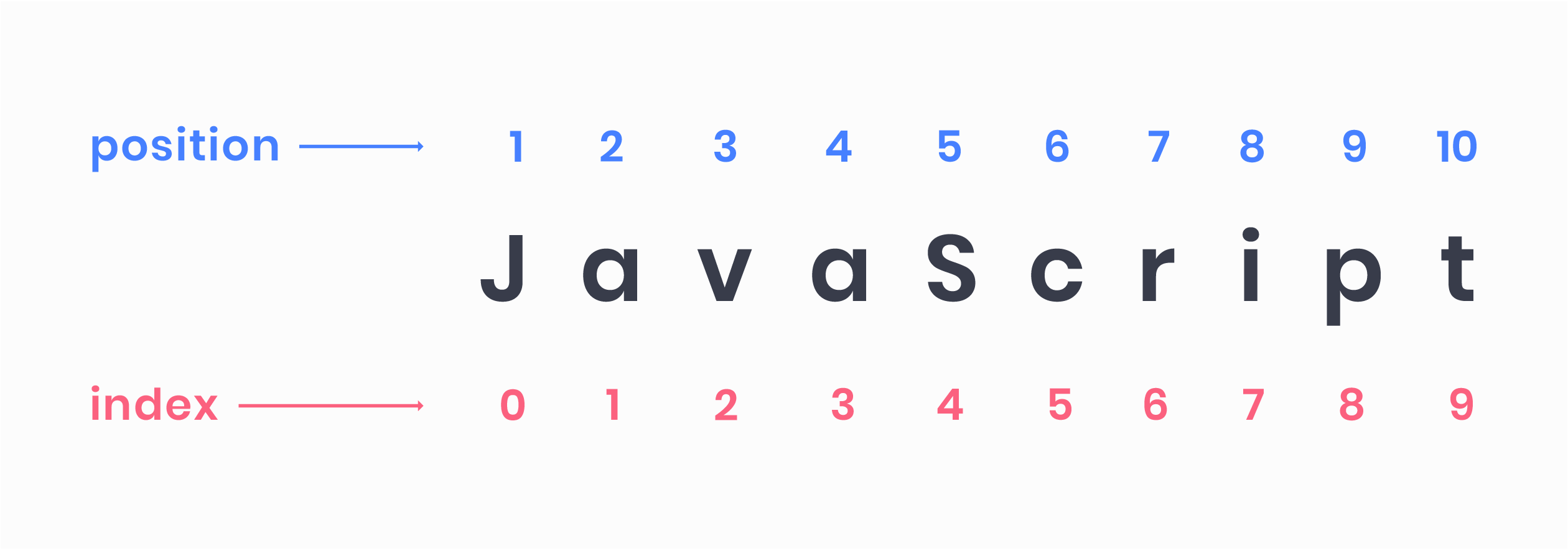Strings
String is an indexed set of zero or more characters, enclosed in single or double quotes.
const username = "Mango";
It is important to remember that the indexing of string elements starts at zero.
For example, in the string "JavaScript" the letter "J" has a position index
0, and "t" has an index of 9.

The content of a string cannot be changed, only read. That is, you cannot remove a character and replace it after the string has been created, as the change would be permanent. You can only create a new string and assign it to a new variable.
String concatenation
If you apply the + operator to a string and any other data type, the result of
this addition is a string. This operation is called concatenation, or string
addition.
During concatenation, any data type is converted to a string and joined with a string, but you should mind the sequence of operands.
The sequence of operations matters; typecasting occurs only at the time of addition with a string, whereas up to this moment the usual rules of mathematics apply.
const message = "Mango " + "is" + " happy";
console.log(message); // Mango is happy
Let's look at different orders of operands.
console.log(1 + "2"); // "12"
console.log(1 + "2" + 4); // "124"
console.log(1 + 2 + "4"); // "34"
In the last example, you can see a mathematical addition operation for the first
two numbers 1 and 2, after which the number 3 is converted to the string
"3" and joined with the string "4".
Template strings
Template strings are an alternative to concatenation with more convenient
syntax. Template strings are enclosed in backquotes instead of double or single
quotes, and they may contain placeholders with the dollar sign and curly
braces - ${expression}.
// Using variables, you need to make a string with substituted values
const guestName = "Mango";
const roomNumber = 207;
const greeting =
"Welcome " + guestName + ", your room number is " + roomNumber + "!";
console.log(greeting); // "Welcome Mango, your room number is 207!"
It is very cumbersome to make strings with substituted values using concatenation. Template strings and interpolation come to the rescue.
const guestName = "Mango";
const roomNumber = 207;
const greeting = `Welcome ${guestName}, your room number is ${roomNumber}!`;
console.log(greeting); // "Welcome Mango, your room number is 207!"
String properties and methods
Each line has built-in properties and methods, let's look at some of them.
length property
In order to find out the length of a string, that is, the number of its
characters, all strings have a built-in property, length. You can get its
value by accessing it through a dot after the name of a variable or string
literal.
const message = "Welcome to Bahamas!";
console.log(message.length); // 19
console.log("There is nothing impossible to him who will try".length); // 47
toLowerCase() and toUpperCase() methods
They return a new string in the appropriate case without modifying the original string.
const message = "Welcome to Bahamas!";
console.log(message.toLowerCase()); // "welcome to bahamas!"
console.log(message.toUpperCase()); // "WELCOME TO BAHAMAS!"
console.log(message); // "Welcome to Bahamas!"
There are situations where all characters in a string need to be converted to
one case, upper or lower. For example, when searching for a keyword, if the user
enters the string 'saMsUng', which must be compared with the string
'samsung' or 'SAMSUNG'.
console.log("saMsUng" === "samsung"); // false
console.log("saMsUng" === "SAMSUNG"); // false
In order not to require a 100% accurate input, you can "normalize" the string
entered by the user, that is, convert all its characters to upper or lower case.
The toLowerCase() and toUpperCase() string methods return a new string in
the appropriate case, without changing the original one.
const BRAND_NAME = "SAMSUNG";
const userInput = "saMsUng";
const normalizedToUpperCaseInput = userInput.toUpperCase();
console.log(userInput); // 'saMsUng'
console.log(userInput === BRAND_NAME); // false
console.log(normalizedToUpperCaseInput); // 'SAMSUNG'
console.log(normalizedToUpperCaseInput === BRAND_NAME); // true
indexOf() method
It returns the position (index) of the first substring match, or -1 if nothing
is found.
const message = "Welcome to Bahamas!";
console.log(message.indexOf("to")); // 8
console.log(message.indexOf("hello")); // -1
includes() method
It checks if a substring is included in the string, returns boolean true if
included and false otherwise. The case of characters in a string and substring
is important, since, for example, the letter "a" is not equal to the letter
"А".
const productName = "Maintenance droid";
console.log(productName.includes("n")); // true
console.log(productName.includes("N")); // false
console.log(productName.includes("droid")); // true
console.log(productName.includes("Droid")); // false
console.log(productName.includes("Maintenance")); // true
console.log(productName.includes("maintenance")); // false
All string methods are case sensitive.
endsWith() method
It helps determine if a string ends with the characters (substring) specified in
parentheses, returning true or false.
const jsFileName = "script.js";
console.log(jsFileName.endsWith(".js")); // true
const cssFileName = "styles.css";
console.log(cssFileName.endsWith(".js")); // false
replace() and replaceAll() methods
They return a new string in which the first (replace) or all (replaceAll) substring matches have been replaced with the specified value.
const jsFileName = "script.js";
const minifiedJsFileName = jsFileName.replace(".js", ".min.js");
console.log(minifiedJsFileName); // "script.min.js"
const cssFileNames = "styles.css, about.css, portfolio.css";
const minifiedCssFileNames = cssFileNames.replaceAll(".css", ".min.css");
console.log(minifiedCssFileNames); // "styles.min.css, about.min.css, portfolio.min.css"